Curiously contemplating the coconut-consuming creatures of the animal kingdom? Wonder no more, as we explore the fascinating world of animals that relish in the tropical treat of coconuts.
From the mighty Coconut Crabs and their remarkable pincers, to the resourceful Elephants and their unique method of consumption, to the herbivorous Gorillas and their strong jaws, and even the mischievous Aye-Ayes with their nimble fingers, these animals have all discovered ways to indulge in the nourishing goodness of coconuts.
But wait, there’s more! Rhinoceros Beetles, Monkeys, and Bears also join the coconut-eating club.
So, hang on tight as we unveil the secrets of these coconut connoisseurs.
Coconut Crabs
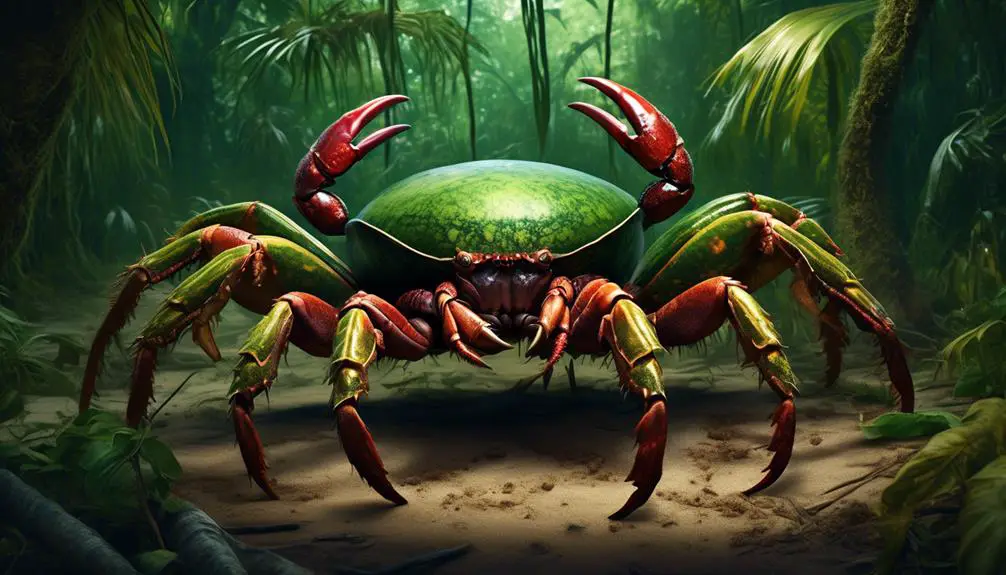
Coconut crabs, the largest terrestrial arthropods, are known for their impressive ability to consume the flesh of coconuts. These remarkable creatures, also known as Birgus latro, inhabit the land and have a diverse diet that includes various fruits, nuts, and fallen tree pith. With their robust pincers, they’re able to remove the fibrous outer layer of the coconut using a comb-like structure. To access the delicious flesh inside, coconut crabs identify the weakest spot on the coconut and apply pressure, effectively breaking it open.
Their ability to consume coconuts isn’t only fascinating but also crucial for their survival. Coconuts provide the necessary calories for maintaining their body weight. Additionally, the high fiber content aids in digestion and helps maintain a healthy digestive system. The coconut crab’s methodical approach to breaking open coconuts showcases their adaptability and resourcefulness as they utilize their strong pincers and keen sense of identifying the weakest point.
Elephants
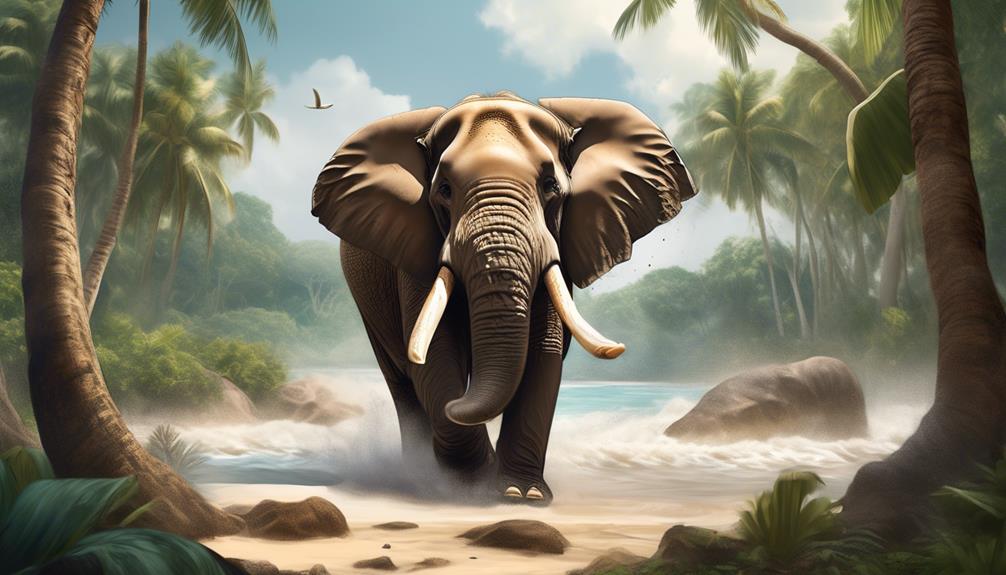
Continuing our exploration of animals that consume coconuts, let’s now turn our attention to the magnificent elephants. Elephants are known to have a fondness for the thick white flesh of coconuts. Although they’re unable to remove the flesh from the shell, they consume the whole fruit. Some elephants even use their feet to crack open coconuts.
The high fiber content of coconuts aids in digestion and helps maintain a healthy digestive system for these gentle giants. Additionally, coconuts provide the necessary calories for elephants to maintain their body weight.
Elephants play a crucial role in dispersing coconut seeds, as they eat the fruit and then excrete the seeds in a different location. This helps in the regeneration and spread of coconut trees in their habitat. Due to their large size and strength, elephants are able to access coconuts that are higher up in the trees, contributing to the dispersion of seeds across a wider area.
Gorillas
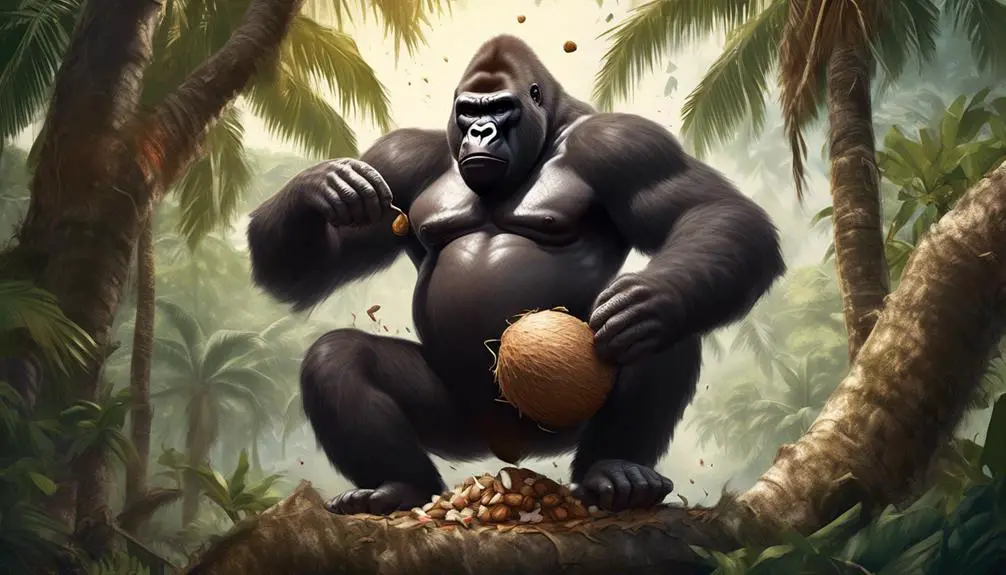
Gorillas, as herbivores, consume coconuts both in the wild and in captivity. They’ve developed a strategy for breaking open coconuts by either striking them against rocks or using stones to hit the seed.
Gorillas only consume the flesh inside the kernel, which provides them with essential calories, minerals, and vitamins in their diet.
Gorillas: Coconut Consumption
Gorillas exhibit a fascinating dietary behavior by including coconuts as part of their food sources in both wild and captive settings. As herbivores, gorillas consume coconuts by breaking them open. They employ a method of striking the coconut against rocks or hitting the seed with a stone to access the flesh inside the kernel. Their strong jaws are capable of ripping through the outer fibrous layer of the coconut.
However, gorillas only consume the flesh inside the kernel and don’t eat the entire fruit. Coconuts provide gorillas with essential calories, minerals, and vitamins, contributing to their overall diet. This unique behavior showcases the adaptability and resourcefulness of gorillas in acquiring nutritional sustenance.
Gorillas: Nutritional Benefits
After exploring how gorillas incorporate coconuts into their diet, it’s important to understand the nutritional benefits that these fruits provide for these remarkable herbivores.
Coconuts are a rich source of calories, minerals, and vitamins that are essential for the gorillas’ diet. The flesh inside the kernel of the coconut is highly nutritious, providing gorillas with the energy they need to sustain their large bodies.
Additionally, coconuts contain a variety of minerals, including potassium, magnesium, and phosphorus, which are crucial for maintaining healthy bodily functions. They also provide vitamins such as vitamin C, vitamin E, and B-complex vitamins, which support gorillas’ overall health and immune system.
With their strong jaws and ability to break open coconuts, gorillas can fully benefit from the nutritional value these fruits offer.
Aye-Ayes
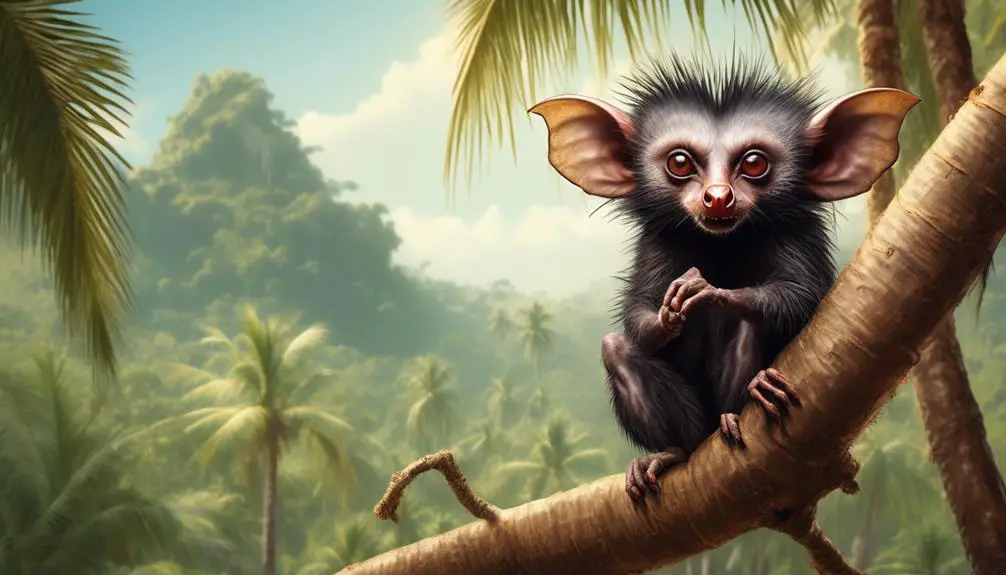
Aye-Ayes, unique primates found in Madagascar, have developed a specialized technique using their long, thin fingers to extract the flesh from coconuts. These nocturnal creatures have a highly adapted anatomy that allows them to manipulate and extract the nutritious coconut meat.
Aye-Ayes possess elongated fingers, which they use to tap on the hard shell of the coconut to locate the soft spots. Once a suitable spot is identified, they skillfully insert their thin fingers into the small crevices and pry open the coconut. With their precise dexterity, they scoop out the delicious flesh, which serves as a valuable food source for them in their natural habitat.
The aye-ayes’ unique feeding behavior has caused them to be considered pests by coconut farmers, as they can cause damage to the coconuts. However, it’s important to note that aye-ayes play a significant role in the ecosystem as seed dispersers. While extracting the coconut meat, they inadvertently drop some of the seeds, contributing to the dispersal and regeneration of coconut trees in their environment.
Rhinoceros Beetles
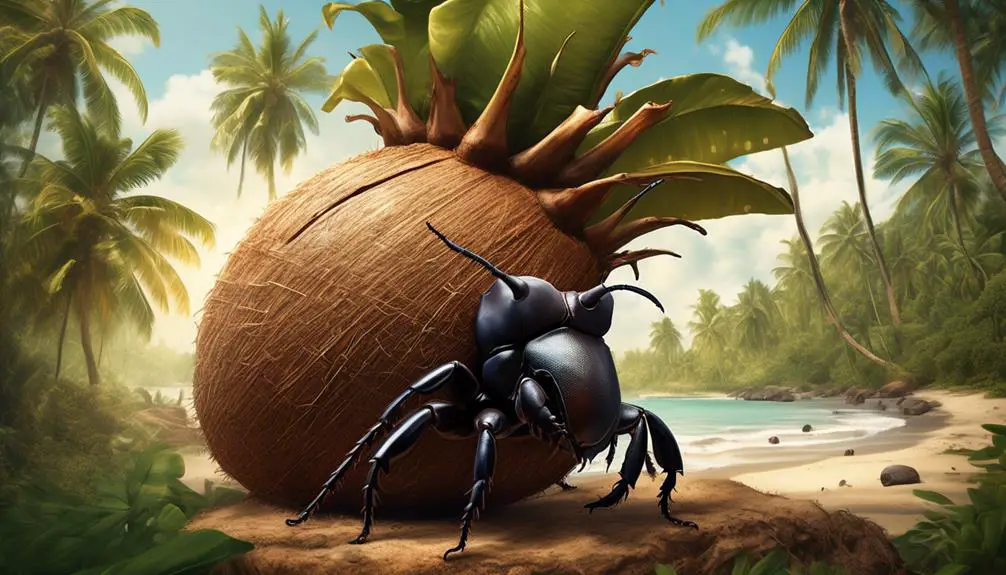
Rhinoceros beetles, giant tropical insects, have a significant impact on coconut trees. They bore through them, potentially destroying entire plantations. These beetles feed on the sap and fluids found in coconuts, as well as other fruits, nuts, and tree parts.
Understanding their feeding habits and finding effective prevention methods is crucial in mitigating the devastating effects of beetle infestation on coconut crops.
Monkeys
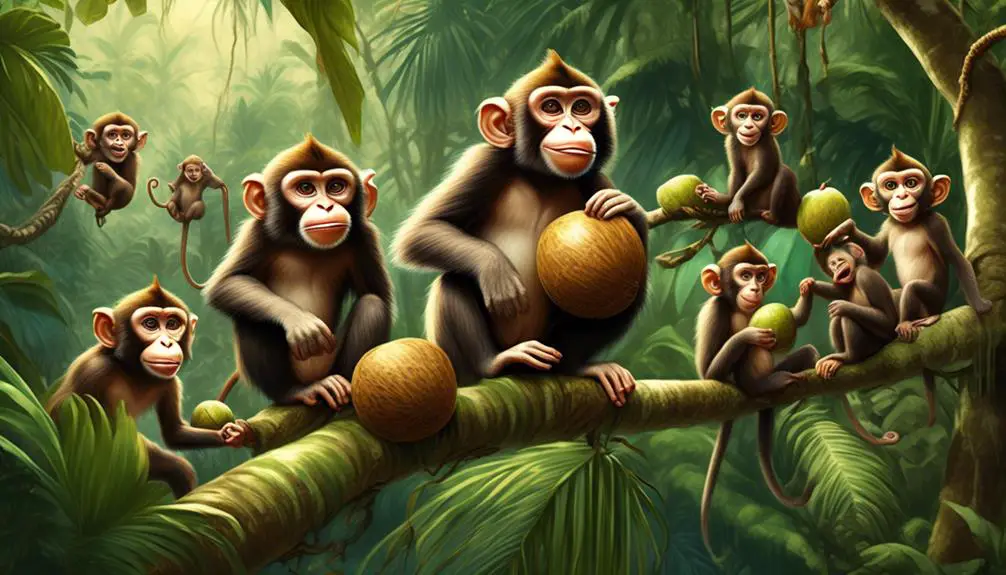
Monkeys, agile climbers and skilled in the art of coconut harvesting, have long been debated for their natural ability to consume these tropical fruits. While some argue that monkeys don’t naturally eat coconuts, there’s evidence to suggest otherwise.
Certain monkey species, such as macaques and capuchins, have been observed breaking open coconuts to access the flesh inside. These resourceful primates use their dexterous hands and strong jaws to crack open the tough fibrous outer layer of coconuts. Once opened, they extract the tender flesh, discarding the outer shell. Young coconuts, with their softer outer layer, are preferred by monkeys over mature ones.
Monkeys’ ability to consume coconuts isn’t only a testament to their adaptability but also to their dietary needs. Coconuts provide a rich source of calories, minerals, and vitamins, which are essential for the monkeys’ overall health and well-being. In certain regions, monkeys have even been trained to pick coconuts, showcasing their intelligence and versatility.
While not all monkey species consume coconuts, those that do have clearly developed strategies to access the nutritious flesh inside. Their natural ability to consume coconuts adds to the diversity of animal species that rely on these tropical fruits as a valuable food source.
Bears
Bears, as omnivores, have a natural affinity for various nuts, including coconuts, due to the sweetness of the water and the juiciness of the flesh. While they aren’t typically considered as coconut eaters, bears are opportunistic feeders and will consume coconuts if they come across them in their habitat. Bears are known for their strength and dexterity, which allows them to climb trees to access coconuts. Using their powerful forelimbs, they can tear open the tough fibrous outer layer of the coconut.
However, it’s important to note that bears may prefer young coconuts over mature ones. This is because the flesh of young coconuts is more tender and easier to consume. Bears, being omnivores, have a varied diet that includes fruits, nuts, berries, insects, and even meat. Coconuts provide a valuable source of calories and nutrients for bears, helping them to sustain their energy levels in their natural habitat.
Final Thoughts

Now let’s explore the points of animal adaptations and their impact on the coconut industry.
Understanding how animals have adapted to consume coconuts can provide valuable insights into the ecological dynamics of coconut ecosystems.
Additionally, examining the impact of these animals on the coconut industry can help us better manage and protect this valuable crop.
Animal Adaptations
Coconut-eating animals have developed remarkable adaptations to access and consume the nutritious flesh of coconuts. Among these animals are the coconut crabs, which are the largest terrestrial arthropods. They’ve strong pincers that allow them to remove the fibrous outer layer of the coconut using a comb-like structure. To open the coconut, they identify the weakest spot and apply pressure.
Elephants, on the other hand, are unable to remove the flesh from the shell, so they consume the whole fruit. Some elephants even use their feet to crack open the coconuts. Gorillas, known for their strong jaws, break open coconuts by striking them against rocks or hitting the seed with a stone. As for the aye-ayes, these unique primates use their long, thin fingers to extract the flesh from the coconut.
Rhinoceros beetles bore through coconut trees, while monkeys break open coconuts to access the flesh inside. Bears, attracted to the sweetness of coconut water and the juiciness of the flesh, can climb trees and tear open the tough fibrous outer layer.
These animals have adapted in various ways to make use of the valuable resources provided by coconuts.
Impact on Coconut Industry
The impact of coconut-eating animals on the coconut industry is significant and multifaceted. These animals play a crucial role in the dispersal of coconuts, helping to spread coconut trees to new areas. However, their consumption of coconuts can also have negative consequences for coconut farmers. For example, the infestation of rhinoceros beetles can destroy entire coconut plantations, causing economic losses. Additionally, monkeys trained to pick coconuts in certain countries can damage the crop while harvesting. To give you a better understanding of the impact, here is a table summarizing the effects of coconut-eating animals on the coconut industry:
| Animal | Positive Effects | Negative Effects |
|---|---|---|
| Coconut Crabs | Aid in seed dispersal | Damage coconut trees |
| Elephants | Aid in seed dispersal | Crop damage during consumption |
| Gorillas | Aid in seed dispersal | Crop damage during consumption |
| Aye-Ayes | Aid in seed dispersal | Crop damage during extraction |
| Rhinoceros Beetles | Aid in seed dispersal | Destruction of coconut plantations |
| Monkeys | Aid in seed dispersal | Crop damage during harvesting |
| Bears | Aid in seed dispersal | Crop damage during consumption |
As you can see, while coconut-eating animals contribute to the dispersal of coconuts and the growth of coconut trees, they can also pose challenges for coconut farmers. Balancing the benefits and drawbacks of these interactions is crucial for the sustainability of the coconut industry.

Erzsebet Frey (Eli Frey) is an ecologist and online entrepreneur with a Master of Science in Ecology from the University of Belgrade. Originally from Serbia, she has lived in Sri Lanka since 2017. Eli has worked internationally in countries like Oman, Brazil, Germany, and Sri Lanka. In 2018, she expanded into SEO and blogging, completing courses from UC Davis and Edinburgh. Eli has founded multiple websites focused on biology, ecology, environmental science, sustainable and simple living, and outdoor activities. She enjoys creating nature and simple living videos on YouTube and participates in speleology, diving, and hiking.

